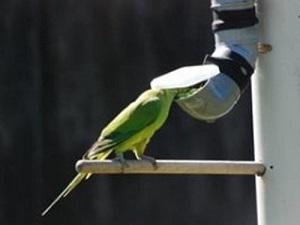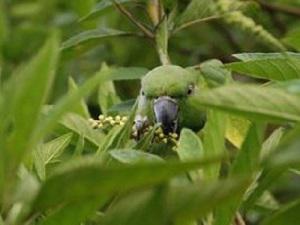Simon Tollington
Other projects
8 Feb 2010
A Novel Approach to Disease Management; Applying Immunoassays in the Field to Select Immunocompetent Individuals of the Endangered Mauritius Parakeet for Future Reintroduction
25 Jun 2014
Maximising the Conservation Value of Supplemental Feeding by Analysing Stable Isotopes to Determine the Seasonal Foraging Behaviour of Mauritius Parakeets
This project aims to identify the optimum level of supplemental food required in order to maintain a sustainable population of endangered parakeets whilst minimising cost and human intervention.

Free food.
Supplementary feeding has been a valuable tool in the recovery of the endangered Mauritius parakeet but potentially increases risks of horizontal pathogen transmission. Habitat degradation has lead to reduced availability of natural food resources and the provision of food is especially important for enhancing productivity of the recovering population. Currently provided ad infinitum for twelve months of the year, it is not known if individuals rely on provisioning or use it as a ‘free lunch’. Stable isotope analysis of the composition of individuals’ diets will reveal how reliant birds are on this resource, so as to develop more sustainable management.

Natural foraging.
Whilst detailed records suggest that individuals consume supplementary food to varying degrees, the exact amount consumed by each individual is very difficult to quantify using field observation alone. Around two thirds of the population are known to regularly visit feeding stations whilst approximately a quarter of all individuals rely exclusively on naturally available food sources. The provision of unlimited, commercially available parrot food has been an effective tool in establishing, maintaining and monitoring this recovering species. It has however, led to an increased density of individuals around feeding stations, potentially leading to increased inbreeding, horizontal pathogen transmission and discourages dispersal into the available and uninhabited surrounding areas of suitable forest. In addition it is possible that this provision of food is creating an ‘ecological trap’ and is not providing all the necessary components of a naturally derived diet.
Preliminary results from a previous RSG funded investigation into immune function suggest that whilst supplementary fed individuals produce more chicks than non-fed birds, these chicks display a weakened immune system, are more susceptible to disease and are therefore less likely to survive to breeding age. An outbreak of Psittacine Beak and Feather Disease (PBFD) in 2005 is now one of the major factors limiting the growth of this population.
The principle aim of this study is to quantify the proportion of nutrition derived from supplementary food for around 75 individuals encompassing the full range of predicted consumption levels. Existing data concerning individual infection status of a range of pathogens (PBFD, leucocytozoon and avian malaria) will then be used to ascertain the levels of infection associated with dietary content derived from supplementary food. This research will help conservation managers design a more sustainable feeding regime which reduces cost, human intervention, pathogen transmission and inbreeding.